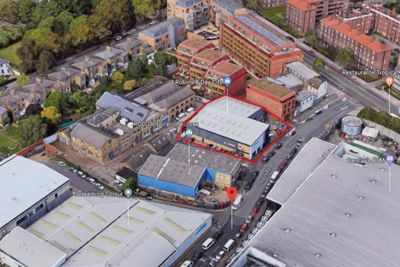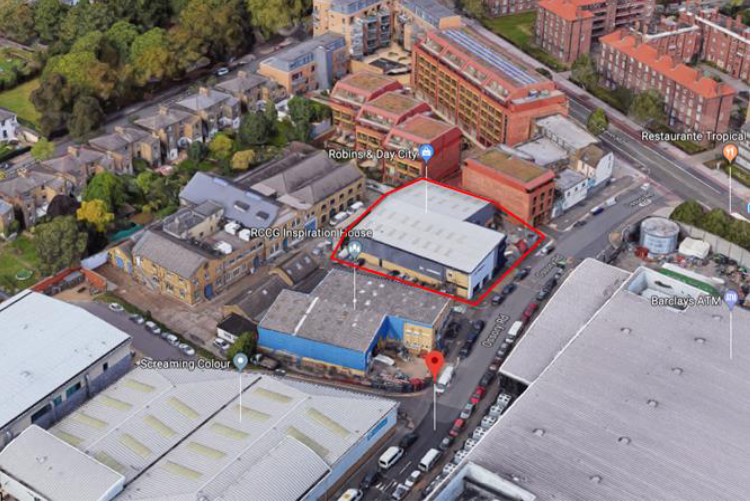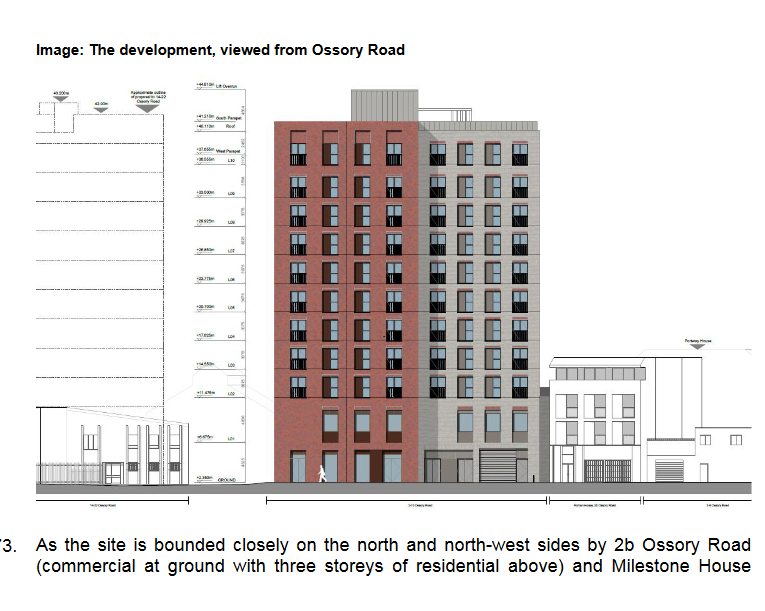
Southwark Council is set to approve a mixed-used residential scheme in the Old Kent Rd Opportunity Area with no social rented housing or family housing, at its planning committee meeting this evening.

The proposed development on Ossory Rd is for 105 units of housing, with light industrial space beneath this. All 105 units will be affordable housing, but of the most expensive type, sold at 80% market value. The applicant is Pocket Living, which specialises in maximising the amount of housing on small sites. All the homes will be one-bed, one person units, without family housing. This is the second such Pocket Living development in the area; the first, in Varcoe Rd had 57 units and a third, Credon House, also for 57 units is in the pipeline.

Pocket Living make up their own rules
Southwark Council requires 35% affordable housing, 70% of which should be social rented, on all developments of this size. This has been the case since 2007 and the requirement has been retained in a succession of local planning documents, up to the draft New Southwark Plan and the Old Kent Rd Area Action Plan. All major approved developments within the Old Kent Rd have pledged to deliver that amount.

There should also be at least 20% family housing of 3, 4, 5-beds in major developments and 60% of should comprise 2-bed homes[^1].
Pocket Living, however, want to make up their own rules. Their sites are small and it wishes to maximise the number of homes built, so they are all one -bed/one person units, though 10% of their occupants appear to be couples, with most units barely above the minimum size allowed (37 sq metres) [^2].
The amount of open and amenity space for occupants is also squeezed. In a development of this size there should be 1,050 sqm private amenity space, Pocket are providing a miniscule 42 sqm. Developers can compensate for a lack of private space with more communal space, but Pocket falls well short here, too, providing less than half the amount required (506 sqm instead of 1,058 sqm) [^3] .
Not that affordable
Pocket Living justify their radical departures from Southwark’s affordable housing requirements, by claiming they are serving the hard-pressed, young first-time buyer and supply their own statistics and census figures to back this up, dutifully reproduced by the officer’s report, which recommends approval of the scheme [^4]. The report also makes the confusing claim that the affordable housing offer is policy compliant:

Buying a decent home in London is undoubtedly hard for the young professionals Pocket Living housing is squarely aimed at, but they are still relatively much better off than those excluded by the absence of social and family housing from Pocket Living developments. Pocket’s typical purchaser will have an average income of £44,000 (OR, Para 60), an income enjoyed by less than 4.5% of Southwark’s households. Pocket Living estimates that its homes will sell for approximately £300k each (with the 20% discount). Supplying homes at these prices to those who earn £44k per year, at the expense of those who earn barely half that is not what affordable housing should be about[^5].

Density and un-exemplary design
Unsurprisingly, given Pocket’s ambitions to maximise the number of units, they are proposing a scheme which is twice the density it should be, (at 2,333 habitable rooms per hectare against a maximum allowed of 1,100 hrph), justified on the basis of exemplary design. However, many of the measures for ‘exemplary’ design are not met – it does not have enough amenity space, there is no ‘predominance’ of dual aspect flats, it does not have any 2-bed or more flats, and the flats do not ‘significantly exceed minimum floor-space standards’ [^6].
Equality not a great consideration
The lack of social and family housing and the provision of all the homes as single bed units, targeted at middle income professionals, would also seem to have clear implications for the various social groups protected under equalities legislation. Southwark have a legal duty to consider this, but have not done so in any detail, content just to note of affordable housing, that there is ‘a high demand for such accommodation and a relatively high BAME population’ [^7].
Viability and the Bakerloo Line Extension
The officer’s report and recommendation for approval was written before press-reports that the Bakerloo Line extension has fallen down the list of priorities for Transport for London (TfL) and may not be built for many years. Pocket Living’s proposal is, according to themselves, technically non-viable and depends upon the delivery of the BLE to turn a profit (as do many other Old Kent Rd schemes) [^8]. There is no mention of a late stage review of the scheme’s viability, which removes the possibility of any improvement in the affordable housing offer, such as a greater discount in the selling price.
The Mayor likes it
While Pocket Living pretty much ignores Southwark’s own housing policy, so does the officer’s report to the planning committee, which notes the departures, but nonetheless recommends approval on other ‘material’ grounds. The report also cites the enthusiastic support of the Mayor (matching his enthusiasm for Build to Rent, another middle/upper income affordable housing tenure that sacrifices social rent)[^9].
What we say...
It is hard to see what this scheme brings to the Old Kent Rd, in housing terms. It has no social housing and no family housing. The affordable housing it does provide is of the most expensive kind. The scheme does not have the private and public space that it should have and it serves a very narrow demographic, while excluding broader sections of the community.
Pocket Living would argue that the constraints of the site and the housing needs of a relatively well-off section of the community should outweigh these shortcomings, but Southwark’s local plan already addresses how much housing there should be for different income groups, with the overarching aim of building a mixed and cohesive community. Pocket Living simply ignores this, so the planning committee should reject this application.
You can find the 35% Campaign objection to this development here.
Footnotes:
[^1]: Southwark's Core Strategy Strategic Policy 7 - Family homes, pg 86
[^2]: Officer Report Table pg 42
[^3]: Officer Report para 133,134,135
[^4]: Officer Report para 112
[^5]: New Southwark Plan Submission Version Jan 2020 Fig 2
[^6]: Officer Report para 118, 119
[^7]: Officer Report para 28
[^8]: Officer Report para 64, 65
[^9]: Officer Report para 229-237; 57